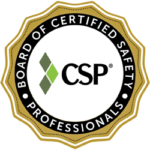Mold is a common problem in many houses as well as commercial buildings. It is important to be aware of the types of mold that exist so you’ll know how to deal with them properly. In this blog, we’ll be exploring the most common types of house mold, where they might be found, and their potential health risks.

RPF Environmental is a certified environmental testing and consulting company that provides mold testing services for various industries and institutions. We have offices in Maine, New Hampshire, and Massachusetts to serve homes and businesses nationwide.
3 Major Classifications of the Types of Mold in Homes and Businesses
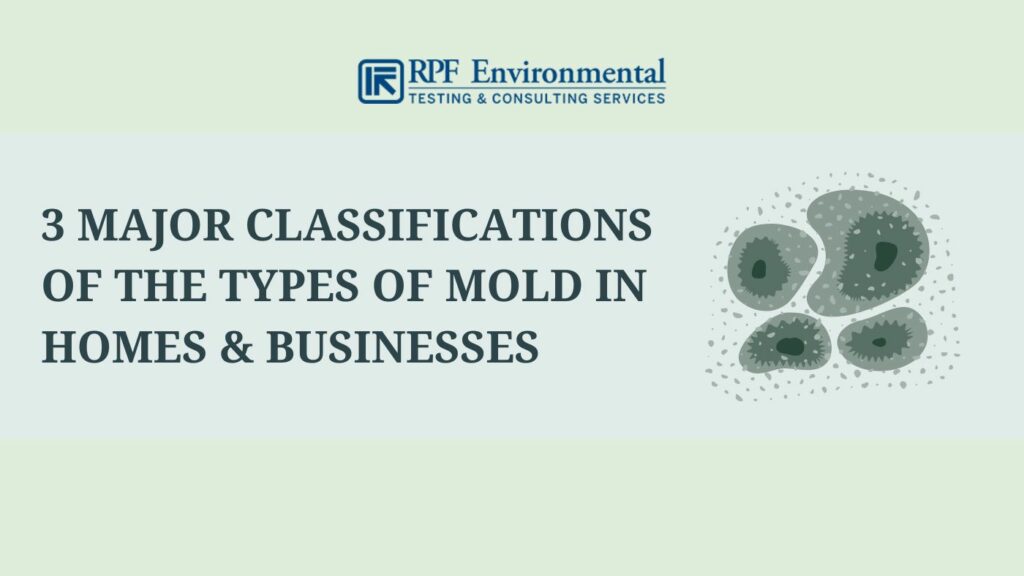
There are different types of mold species in homes. But in general, they can be divided into three main categories: allergenic, pathogenic, and toxigenic.
1. Allergenic Mold
Threat: Low to Moderate
Allergenic molds are very common molds in homes that are not toxic but can cause allergic reactions and trigger asthma attacks. The symptoms will depend on how sensitive you are to mold spores. You may feel nothing to more serious reactions. They are often harmless in small quantities but can cause severe reactions in large quantities for individuals who have asthma or are sensitive to mold.
Moreover, you can usually clean allergenic mold using DIY cleaning methods, but make sure to still wear protective gear. (Read our blog on cleaning mold yourself here.)
Symptoms
- Sneezing
- Runny nose
- Watery or itchy eyes
- Coughing
- Skin irritation including dry skin
- Sore throat
- Asthma symptoms
2. Pathogenic Mold
Threat: Moderate to High
Pathogenic molds are less common than allergenic molds and can cause infections both in healthy and immunocompromised individuals. What characterizes them is that the mold actually grows on or in a person’s tissues and organs. This can happen once the spores are inhaled or the skin comes into contact with the mold. Also, people with weak immune systems and existing conditions can experience more severe reactions in large quantities. These include small children and the elderly.
Symptoms
- Heavy coughing
- Shortness of breath
- Skin infection
- Lung infection
- Moderate to severe allergic reactions
3. Toxigenic Mold
Threat: High to Extreme
Toxigenic molds are rare types of molds that usually occur when the infestation gets worse. They are harmful to both humans and animals and often require professional remediation. DIY removal is not recommended for these types of molds as you might end up spreading the infestation further and putting your family at risk.
Moreover, toxigenic molds can produce mycotoxins under specific conditions and can cause serious health complications like respiratory failure if ingested, especially in high-risk individuals. The popular black mold is an example of a toxigenic mold. But, take note that mold color is not always a good basis when it comes to toxicity as mold color can change over time.
Symptoms
- Severe reactions like respiratory failure
There have been some reports of toxigenic mold causing rare health conditions like memory loss or pulmonary hemorrhage. But, CDC stated that the link between these conditions and toxigenic mold hasn’t been proven.
NOTE: Some strains of allergenic molds are pathogenic or toxigenic. So regardless of the type of mold you are dealing with, immediate remediation is required. Visual inspection alone is not enough to properly identify the type of mold in your home/business.
17 Common Mold Types in the House by Category
In addition, below are the specific types of mold you can find indoors and areas near your home according to the three main categories:
Allergenic Molds
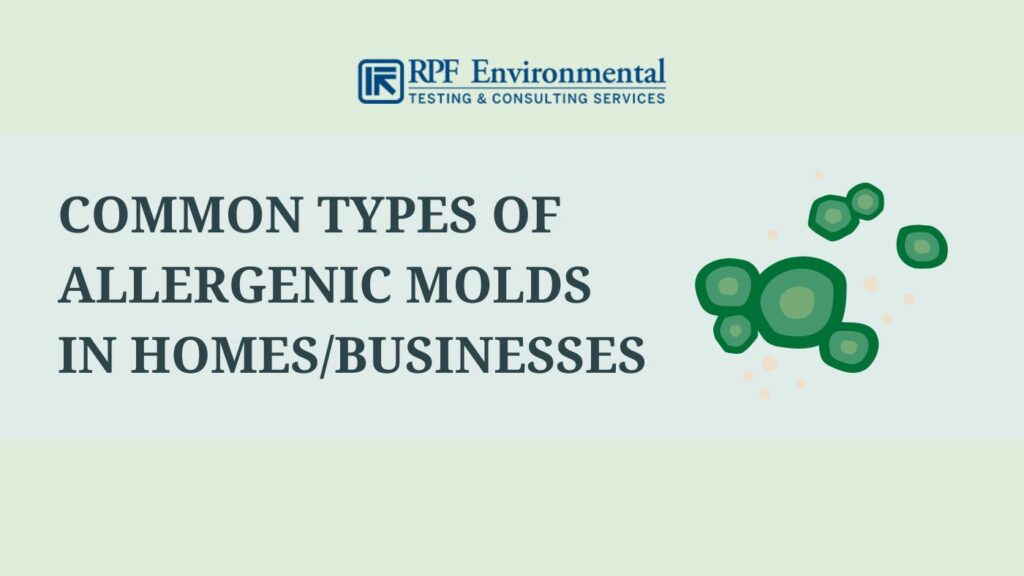
1. Alternaria
| Description | Where it is Commonly Found | Health Complications |
|---|---|---|
| – One of the most common indoor molds and appears dark in color (almost black or gray-green) – Prevalent in dry and warm climates, so there is a high concentration of spores during summer in temperate climates – A plant pathogen infecting fruits and vegetables | – Soil, plants, fruits, vegetables, rotten wood, compost, etc. – HVAC systems, drywall, carpet, wallpaper, ceiling tiles, window frames, textiles | – Strongly linked to allergic rhinitis (hay fever) and asthma – Most common mold allergy in children with asthma |
2. Most Aspergillus species
| Description | Where it is Commonly Found | Health Complications |
|---|---|---|
| – Very common types of mold – Can be gray, greenish, or dark in color | – Soil, grains, seeds, decaying vegetation, houseplants – Crawl spaces, walls, ceilings, subfloor, etc. | – Mild allergic reactions – Minor health complications – Lung disease and more serious reactions for immunocompromised individuals |
3. Aureobasidium
| Description | Where it is Commonly Found | Health Complications |
|---|---|---|
| – A fast-growing type of mold that starts as pink or cream-colored and turns black or dark brown later – Slimy and yeast-like fungus – May look like Stachybotrys chartarum – Requires high levels of water to thrive | – Continually damp surfaces like bathrooms and kitchens – Wallpapers, painted walls, wooden furniture, caulk, windows | – Allergic reactions – Hay fever – Humidifier fever |
4. Chaetomium
| Description | Where it is Commonly Found | Health Complications |
|---|---|---|
| – Starts as white and cottony and turns bluish-green once mature – Dark spores that look like footballs – Few spores become airborne until disturbed or completely dried but they are still dangerous | – Water-damaged surfaces – Cellulose-rich surfaces like drywall, ceiling tiles, and wood – Damp soil – Decomposing plants – Fiber-rich food | – Allergic reactions – Respiratory infections – Some species can cause nail and skin infections – Autoimmune diseases |
5. Cladosporium
| Description | Where it is Commonly Found | Health Complications |
|---|---|---|
| – Green, yellow, or black spots – One of the top three most common indoor molds | – Cooling units, damp building materials, carpets, insulation, curtains, decaying plants | – Most species are not harmful but can lead to allergic reactions or worsen asthma – Rare infections in the eye, ear, sinus, or skin |
6. Mucormycetes
| Description | Where it is Commonly Found | Health Complications |
|---|---|---|
| – Mostly allergenic but some can be toxigenic – Dark-hued mold with spherical structures | – Soil, rotting wood, plants, compost piles, decaying organic substrates – Old bread and rotting fruits and vegetables | – Allergic reactions – Some more dangerous species can cause Mucormycosis, a rare infection that mainly affects individuals with health problems – Commonly affects the lungs and sinuses |
7. Penicillium
| Description | Where it is Commonly Found | Health Complications |
|---|---|---|
| – Also one of the most common airborne molds indoors that appears fluffy and blue-green in color – Common species are widespread in subtropical and temperate regions – Popular as antibiotics, but can still cause health complications | – Organic materials (paper and wooden materials, textiles, etc.) – Soil, decaying plants, grains, rotting fruit- Stale bread, nuts, and fruits | – Allergic reactions – Triggers asthma – Sinus infections |
8. Serpula
| Description | Where it is Commonly Found | Health Complications |
|---|---|---|
| – The most popular indoor contaminant species is Serpula lacrymans, known as the dry rot fungus, which causes serious damage to houses by destroying wooden structures even without high moisture | – Old water-damaged surfaces – Any wooden structure that doesn’t need to be always damp | – Rarely causes infections, inflammations, and irritations, but there are documented cases of hypersensitivity pneumonitis and asthma-related effects |
9. Ulocladium
| Description | Where it is Commonly Found | Health Complications |
|---|---|---|
| – Dark-pigmented mold that is usually black and can be confused with Alternaria – Thrives in high moisture and common in areas extremely damaged by water in the past | – Soil, paper, textiles, fibers, wood, emulsion paint – Very wet particleboard and walls | – Allergic reactions – Hay fever – Asthma-like symptoms – Difficulty breathing |
Pathogenic Molds
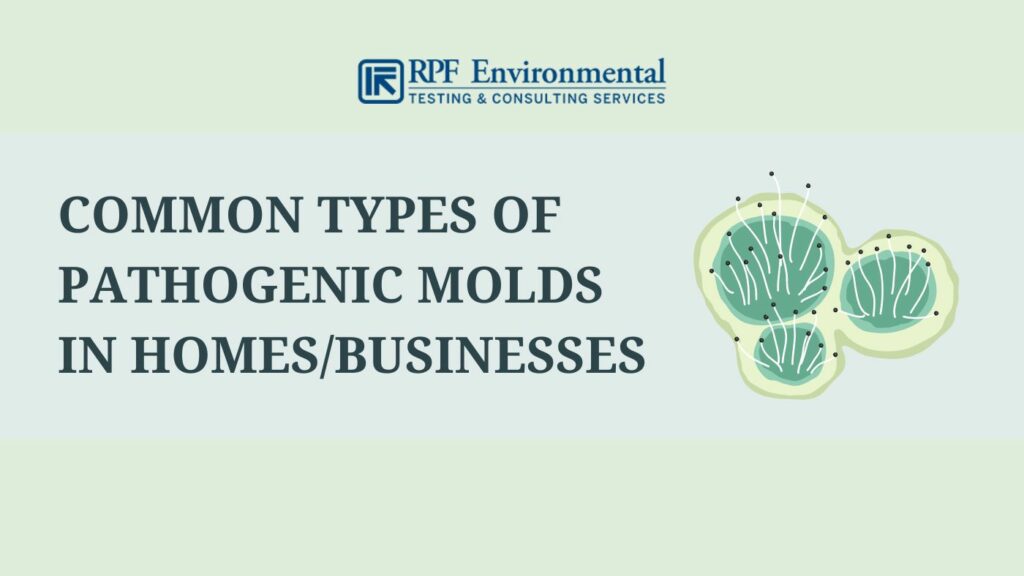
1. Aspergillus fumigatus
| Description | Where it is Commonly Found | Health Complications |
|---|---|---|
| – Known as the most prevalent airborne fungal pathogen – Typically green mold with suede-like surfaces | – Soil, plants, dust, compost heaps, decaying matter with high water content – Moist environments indoors | – Fungal infections even in healthy individuals – Major cause of severe infections in patients with compromised immune systems – Can cause aspergillosis (a common infection caused by molds worldwide) |
2. Cryptococcus neoformans
| Description | Where it is Commonly Found | Health Complications |
|---|---|---|
| – Characterized by an oval or round yeast – Young colonies may appear cream but yellow, orange, or red pigments can be produced – May appear slimy | – Soil contaminated with bird droppings (particularly pigeons), decaying wood, and tree hollows – Environment outside your home | – According to CDC, infections caused by C. neoformans in healthy people are rare because most infections occur in individuals with weak immune systems, especially those with advanced HIV/AIDS – Infections in the lungs and central nervous system |
3. Histoplasma capsulatum
| Description | Where it is Commonly Found | Health Complications |
|---|---|---|
| – One of the most common causes of respiratory infections in healthy individuals (up to 500,000 infections per year) | – Soil with bat or bird droppings – Barns and pigeon and chicken coops | – Can cause Histoplasmosis once the spores reach the lungs and turn into yeast which can lead to life -threatening diseases |
Toxigenic Molds
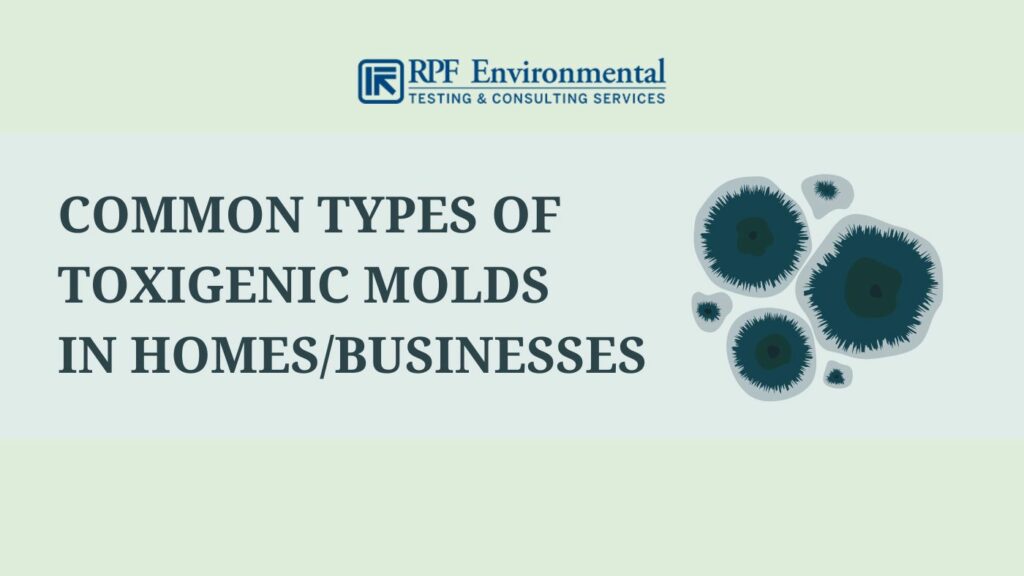
1. Acremonium
| Description | Where it is Commonly Found | Health Complications |
|---|---|---|
| – Starts as a moist mold and turns into a powdery substance – Often white, orange, gray, or pink in color | – Very wet environments like water-damaged areas – Insulation in HVAC systems – Humidifiers – Drain pans – Cooling coils – Window seals | – A carcinogen that can affect the immune system, brain, internal organs, and bone marrow |
2. Some Aspergillus species (A. flavus, A. terreus, and A. niger)
| Description | Where it is Commonly Found | Health Complications |
|---|---|---|
| – A. flavus: Yellowish green surfaces – A. terreus: Brownish but turns dark as it matures – A. niger: Cottony that is initially white or yellow but turns black when mature | – Soil, plants, dust, decaying matter, compost heaps – A. niger is a common food spoilage mold that infects fruits and vegetables | – The mentioned species can cause aspergillosis – Lung and sinus infections that can spread throughout the body like the brain, kidneys, and heart – Bleeding in the lungs |
3. Some Penicillium species like P. cyclopium, P. islandicum, P. viridicatum, P. expansum, P. urticae, and P. citrinum
| Description | Where it is Commonly Found | Health Complications |
|---|---|---|
| – Can be blue, green, orange-brown, blue-gray, light gray, or dark gray-green depending on the species – Often granular | – Food like small grains, soybeans, beans, and corn – Storages and refrigerated foods | – Can cause blurred vision and skin disorders – Suspected to cause respiratory arrest, convulsions, paralysis, and others |
4. Stachybotrys chartarum (known as “black mold”)
| Description | Where it is Commonly Found | Health Complications |
|---|---|---|
| – Extremely dangerous mold that produces mycotoxins when disturbed – Circular spots that can be black, dark brown, or dark green – Looks like black slime but can also be furry with flecks of orange or white | – Materials containing cellulose (e.g organic materials, ceiling tiles, wood, paper materials) – Ducts and ventilation systems | – Prolonged exposure results in a very long list of health complications including severe pain, breathing problems, extreme tiredness, and infections – Issues in the central nervous system |
5. Trichoderma
| Description | Where it is Commonly Found | Health Complications |
|---|---|---|
| – Starts out as yellow or white but turns dark green or gray once it matures – Can be toxic to people but useful as biocontrol agents in agricultural biotechnology | – Mostly found in forests and damp soil – Other damp areas like damp carpeting, paper items, and wood – Gypsum board – Paint – HVAC filters | – Infections are often limited to individuals with weakened immune systems, but certain species like T. viride produce strong mycotoxins that can affect healthy people |
Read more about the common places where you can find mold in homes here.
FAQs
The most common types of indoor molds are allergenic molds with Aspergillus, Cladosporium, and Penicillium being the most commonly found species.
Visual inspection alone including the color cannot guarantee accurate identification of the type of mold. You will need the help of a professional mold testing company for proper identification. We use advanced technology to determine mold type by analyzing their growth structure and spore characteristics.
Most types of toxic mold are black or dark green and usually look slimy, but some can also look grayish and ash-like. However, not all toxic molds are dark in color. Color is not an indication of how toxic mold is. You should consider all types of mold as dangerous, regardless of the color or what it looks like. Call a professional once you spot mold infestation in your home or business.
Stachybotrys chartarum, often referred to as “black mold”, is popularly known to be the most harmful type of mold. This mold produces mycotoxins when disturbed and can cause serious infections, especially to people with compromised immune systems, the elderly, and small children.
Conclusion
There are many types of molds that you can find in residential and commercial buildings. But regardless of the type and toxicity, we highly recommend working with a certified mold inspection and remediation company to ensure the safety of your family or business.
RPF Environmental can help you identify the type of mold in your home/business including hidden mold to guarantee total mold removal. We provide mold inspection services to clients in Maine, New Hampshire, Massachusetts, and other areas Nationwide. Contact us now!



